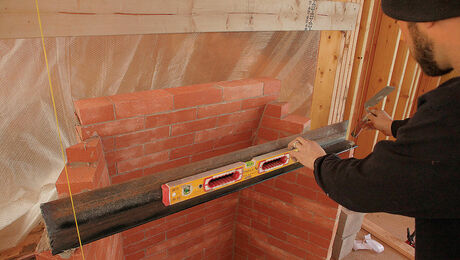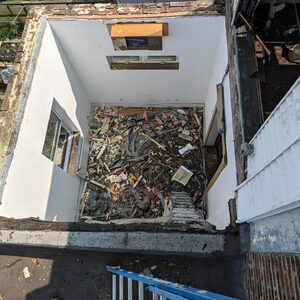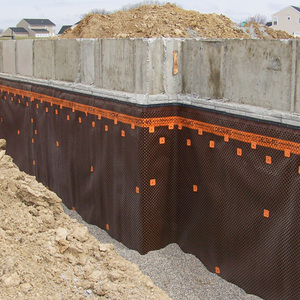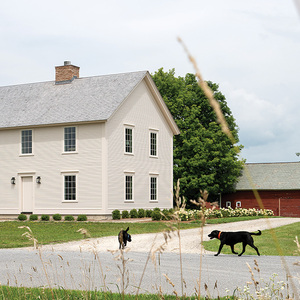insulating the outside of a basement
Hi all, I know this has been discussed in a previous thread and I have searched for the pics that i saw (i think from riversong) but can’t seem to locate them.
We are building a home for a client and are in the planning and budgeting stages of the house. The house is on a hill above a lake and gets a lot of sun in the summer.
The issue we are discussing is using the three sides of the full depth concrete walls as a heating moderator. I realize that our temps don’t fluctuate much here but the HO would like to heat with wood scraps(free and unlimited). The walls would hold the heat over night and he could stoke the wood stove again in the morning. In the Summer he would like the walls to help the building stay cool.
The building faces south but has a full depth foundation basement except on the east where it will be a walk out with 2X6 framed wall. All of the basement will be unfinished unless we insulate inside the walls then we will have to protect the insulation.
The walls by code here only need to be insulated below grade 3′
As for protecting the foam on the outside…There is some stucco on the building so we could stucco over the foam. or maybe sheet metal??
I am looking for tips ie… attachment methods….reasons not to do it…..ways of making the transition from the clading on the building to the 2.5 ” foam look good and stay water proof.
thanks



















Replies
hopefully this will draw a little more attention ...
I don't think the exterior walls are going to get enough heat to do too much, most of the heat will rise to the main floor and escape, now if the furnace was incased by a conc mass then that might be different ...
You are running the insulation all the way down? Or just 3 feet? I installed mine ... 3" EPS down to the footing on a 4 ft wall. I finished the exposed w/ a pre colored flashing I had bent into a shape ... see attached pics.
That looks good. Has that flashing held up over time? (I guess that would depend on when you installed it...)
I think I would just go down 3' or 4'. 4 probably then that would be half sheets. how did you attach yours to the concrete. I was thinking i would use 1/4" holes and 2 - 3" nails with a washer. The attachment would only need to hold till the back fill was in place. I apreciate the pics thank you.
It's been in about 4 years maybe. This was flashing you buy precolored, I think (I got it at the used materials shop). The kind used for e.g. gutters or roof flashing, I think. It was like 14" wide. I'm in Hood River, so similar ... lots of moisture/snow. It still looks as nice as the day I installed it, so, so far so good.
I didn't attach the insulation w/ anything. Can't recall if I simply backfilled a little as I went or maybe the waterproofing (but I installed it in cooler weather, so really didn't have much stickiness to it). I beveled the top at a 45 (matches the flashing).
I think thiis is a standard flashing detail (the use of the bent colored metal).
Thanks I was a little worried about the metal getting dented or scratched as life carried on around them right at that level.
I know I saw some pics here that had stucco covering the foam but I can't find them now. I suppose the same could happen to the stucco with a softer backing to it. the metal wouldn't wick the water up out of the ground either.
Thanks
Yeah ... lots of ways to do it ... pay your money take your choice. The metal is susceptible to physical impact, but so are lots of things. Maybe parge the insulation corner w/ e.g. thinset to provide a more rigid back??? Just thinking out loud and it's early .... good luck
Is that pic from the pacific nw or so cal? I imagine, dependant on where you are in the nw, your climate will be similar to ours.
Edited 1/29/2009 4:27 pm ET by angusj
Isn't that XPS?
Jon Blakemore RappahannockINC.com Fredericksburg, VA
Yes (?) pink board extruded polystyrene. What is abreviation for expanded poly? It's always confusing to me 'cause the names are so close. EPS and XPS? which is which?
Kind of random, because they both begin with "ex," but its:Expanded PolyStyrene (EPS)andeXtruded PolyStyrene (XPS)
Right ... good reminder for all of us. Thanks. Some things I have to keep repeating to myself ... some people think I'm mumbling to myself ... but just reminding myself of how forgetful my feable mind is getting. ;)
angusj
Why don't you just use ICF forms?
Then use fiberglass or steel mesh and stucco it.
Use a 2x12 plate and have your walls flush with the exterior of the ICF.
With blocking and the joists running over the plate the load should be transfered to the foundation.
Rich
At first I thought this would be a great opportunity to use the icf system however the home owner doesn't want to finish the basement at all. He wants to leave the walls bare concrete. As far as I know the walls of the icfs would have to be protected from fire as they burn and give off toxic gasses in the process. Protecting the ICF means drywall and then you have basically started the process of finishing.
I especially like the no condensation behind the dw if someone were to finish the basement at a later date. Spray foam is extremely cost prohibitive here. The HO would also like the thermal mass aspect. He can get all the free firewood he likes so I expect the wood stove will be burning as much as possible. We are installing a firewood chute right into a closet in the basement with double dutch doors for easy access, dry wood storage.
Angus,
Good post. I think I understand what you're after as I've considered this. I'm pretty sure the concrete walls in my basement are sucking up a lot of heat from my woodstove there and transferring it out to the back fill. If I build a fire when the basement's cold it takes a long time before any appreciable amount of heat makes it to the floors above. A couple of things to consider:
Our local building codes are now requiring interior insulated walls in conditioned basements. I'm not sure if they still require this if the outside of the wall is insulated. If you have to insulate the interior walls then you lose the benefit of your concrete as a thermal mass. If the HO plans to finish out the basement at a later time this may become an issue.
If you use ICFs you won't get the benefit of the thermal mass that I think you're looking for as there would be insulation on the inside walls too.
If building codes allow you to insulate only the outside of the foundation and while keeping the interior walls uninsulated in conditioned space then I'd do that. This also has the advantage of preventing condensation on interior walls as they would be closer to the same temp as inside air.
Normally energy codes don't care how you insulate ... as long as it is done. Can vary, though. Where are you located? Sometimes the code has a different insulating value for the exterior than the interior just because of the general difference in the construction and ease of achieving various insulation levels.
I'm in SW VA and its too late for me, my house is built. My interest was more WRT the OPs local regs. Thanks.
I know ... presented the thoughts as much for every one else as much as yourself.
I talked to the inspector about it and he is fine as long as the insulation is 2' below grade and is protected. I am pretty sure that if I insulate the top three feet of the wall and don't cover it with anything. ie foil backed insulation or pinned on roxsal batts, they will be destroyed by the kids playing in the unfinished basement. the inspector has said that they would pass the foil back fiberglass but I think we can do a much better job that will last longer.
All issues are covered it would seem, by putting the insulation on the outside. except of course the cost and the how to protect that top 8" and still have a good looking wall.
Are you concerned about bugs traveling between the insulation and the concrete?
Yes I had thought of that. The site is all gavel and rock so I think bugs will be less here than on many sites. However I was thinking of maybe a borate spray or foam that had that component in it already. The site has been excavated down 22 feet all of the gravel has been sent off site, all sold to pay for the excavating and trucking. not any organics to be seen. We will have to bring some top soils in but it will be really easy to keep it away from the house.
I was also thinking that the metal going down a little into the soil would help as a bug blocker.
It may end up that all the extra costs assosiated with moving the insulation outside mean that we end up going back inside.
why not just have a closed cell spray foam applied. It probably wouldn't need protection, but the sprayer could always coat it in polyurea.
The spray foam is crazy expensive here. No competition at all.